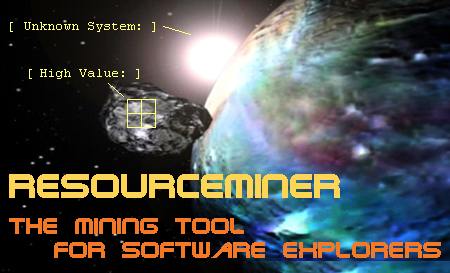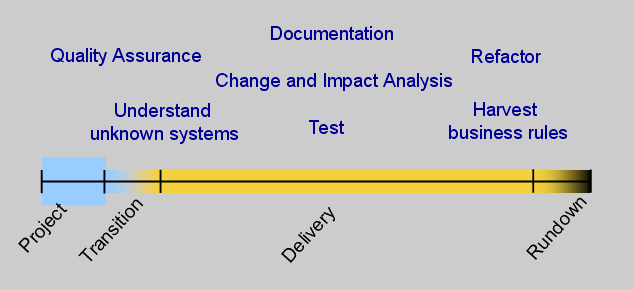Introduction
The problem of the generation shift in the IT industry is known for IT managers and professionals, what is less known is that there are solutions that have successfully been used both by governments and international listed companies.
The basis of the solution is innovative new tools to help the successors to take control of the complexity of the programming code, this in turn helps to unravel how the underlying infrastructure of data, computers and servers are connected. This knowledge is needed to be able to change and develop without making new problems for users which today - in many cases - are you and I through the web or our mobile phones.
Take control
The benefits of ResourceMiner start to show already during introduction at site. In the loading phase an inventory is made and all source code is quality assured. This means that all source code without references (dead code) will be identified and all links in the source code will be verified. We have a proven methodology for how to achieve this quality assurance successfully from single applications up to complete enterprise architectures.
After having a quality assured ResourceMiner database different roles can benefit from it:
- BE FASTER while others spend time searching and understanding source files
- MAKE EASIER to understand unknown parts of applications, no matter size and complexity!
- GIVE ANSWERS quicker and even more accurate
- FEEL COMFORTABLE doing the changes, including the hardest ones you rather avoid
- FIND the DISTINCT TESTCASES that covers your changes
Mastering ResourceMiner saves time and increase quality.

Features
ResourceMiner is a commercial static code analysis tool for software architects and developers. It graphically visualizes the static structure of single or multiple integrated applications written in 30+ legacy and modern languages and all major databases down to the details.
The code structure is displayed as TopDown and BottomUp dependency trees at different levels of abstraction; System, Computer, Tier, Package, Object, Entry, Statement and Data.
UI of ResourceMiner makes it possible to perform and document any analysis tasks at abstraction levels and scopes of interest. Frequently and/or complicated analysis tasks can be automated by using its API. Multi metrics capabilities. Can be used to generate new source from the models in the ResourceMiner database.
ResourceMiner analyze, loads and index source files into a relational database for great scalability and performance.
The add-on Refactor functonality makes it possible to define own rules for masschanges in the source.
Benefits
- More effective and more accurate cost estimations
- "What used to take 3 days can now be done in 3 hours and with higher quality".
- More effective and more accurate identification of code affected by a change request
- "The number of unexpected errors clearly dropped when Impact Analysis became a routine task".
- Facilitates the identification of program errors
- "I can find the origin of a log output in a few mouse clicks".
- Adjust and develop legacy applications despite lack of competence
- "We handled the generation shift successfully with this new innovation".
- Harvest business rules
- "I thought it was impossible to automate business rules extraction from the sources, now I know it is possible".
- Work program language independent and over system boundaries, even portfolio wide
- "This is a disruptive technology, it takes the guess work out of enterprise architecting".
- Generate new source from the models in the ResourceMiner database
- "We could generate the data management routines from the source - much faster and more accurate than our other options".
- ResourceMiner makes it possible to implement APM - Application Portfolio Management.
-
ResourceMiner adds value throughout the entire application life cycle

Common tasks
This is a list of tasks that ResourceMiner is used for:
- Asset Inventory
- Understand Unknown Systems
- Create As-Is Architecture/Design Documentations (overview documentation)
- Migration Assessment
- Define the exact scope(s) of program files and data by the dependencies of the Asset
- Define what integrations need to be handled in a defined Scope
- Harvest Business Rules (detailed requirements)
- Testplan sizing and estimation
- Convert source by generating new source from the language independent format inside RM
- Generate ETL-scripts and/or Access Layers from the source model inside RM
- Generate SOA BusinessServices for C# or Java from the source model inside RM
- Generate Web GUIs consuming BusinessServices from the source model inside RM
- Change Analysis and Estimation
- Quality Assurance Monitoring
- Understand errors, perform impact analysis for possible fixes
- Propagate fixes and masschange (Refactor Add-On needed)
- Instrument source for dynamic analysis (Refactor Add-On needed)
- Design new Testcases targeting changes made
- Generate external interfaces, ie WebServices wrappers etc.
- Generate Harness for Unit Tests
- Automated Testcase Monitoring
- APM - Application Portfolio Management (KPIs based on source)
- Feeds to CMDB
- and more...